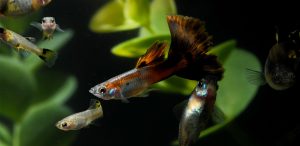
Selecting the Right Fish for Your Tank
Saltwater aquariums usually gets all the hype, but freshwater aquariums offer their own sense of splendor. Many take on the challenges of freshwater setups quite readily, however, there is a good amount of work that goes into establishing a proper tank.
Finding the right fish to work in your tank is part of the challenge. Not all fish will cohabitate happily together, and others aren’t as hardy as you may think. With proper care, any freshwater aquarist, at any level, can be successful. Here’s a breakdown of some tried and true favorites.
Beginner Level: Guppies
Guppies are fun to watch as they school together. Most of the time, you will find these small fish hanging around the surface of their tank, with their elegant tails creating a frenzy of color; it’s the males that boast the most color.
While happily kept together, and with other peaceful freshwater companions, it’s best not to keep males and females together unless you want more guppies than you care to count! These fish belong in the family of livebearers, meaning they don’t lay eggs. Instead, the eggs are fertilized and kept within the mother until they hatch, and are then born as tiny versions of their adult selves.
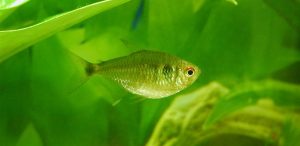
Beginner Level: Black Skirt Tetras
The world of Tetras is quite vast, but each species shares a common trait: the need to school. Black Skirt Tetras are quite hardy and are great for aquarists who are just starting out with their tank. Be sure to keep at least four in a school so they don’t pick at each other too much while establishing a hierarchy.
Black Skirts are a species of Tetra that are quite peaceful, and will even accept other Tetras of differing species in their schools. While certainly not the most colorful fish in the freshwater world, or even the tetra world, for that matter, Black Skirts are a favorite for starters and avid freshwater enthusiasts.
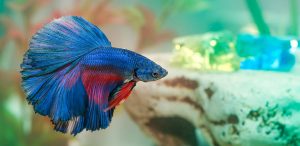
Beginner Level: Bettas
Bettas are one of the easiest fish to care for because they are one of the few that do not require oxygen exchange with filtration. That means these little guys can be kept in setups without all the added noise of a hefty filter.
It is recommended to keep Bettas separate from other fish, as they are very territorial and will have no problem fighting to the death in order to protect their established space. This means that even males and females shouldn’t be kept together as they can quickly lose their romance and turn on each other.
Bettas come in a variety of colors and fin patterns, and are truly extraordinary fish to admire.
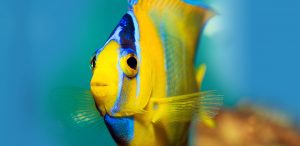
Intermediate Level: Angelfish
With how elegant and delicate Angelfish look, many are surprised to learn that they are part of the Cichlid family. Cichlids are known for being territorial and some are so aggressive they can’t be trusted with many tankmates. Angelfish tend to be more on the docile side, and some are even downright shy.
However, with the proper tank size and plant coverage, these beauties thrive and bring their own flair to a freshwater tank. It’s wise to pay close attention to the other fish you have cohabitating with your Angelfish, since there are many that find this fish’s fins to be fair game as something to pick apart.
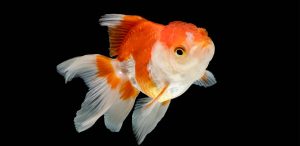
Intermediate Level: Oranda Goldfish
Orandas are easy to spot. They’re the ones with the bulbous brain-like growths adorning their noggins and, and on some, their full faces. These Goldfish grow to a reasonable size of about 7 inches, with some even doubling that in extremely well-cared for ponds and large tanks. These fish are messy and can easily pollute their water with waste if not adequately cared for.
This means you will need a large tank, especially if you’re considering keeping multiples. Some believe Goldfish are extremely easy to care for because they don’t require a heated tank set-up. However, a number of these people fail to realize the rest of the work that goes into caring for these underrated beauties.
When you hear boasts of Goldfish living for a year, know you can counter that with a properly cared for Goldfish thriving for 10 or even 20 years!
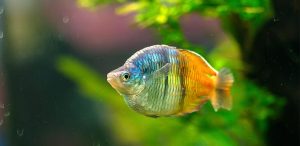
Intermediate Level: Boesemani Rainbowfish
You may hear this peaceful fish referred to as “Boeseman’s Rainbowfish.” Both males and females sport the dramatic features Rainbowfish are known for: large eyes, a deeply forked mouth, and dual dorsal fins. As with many in the freshwater fish world, the males are the ones who boast the most color.
Boesemani Rainbowfish, like many other Rainbowfish species, love to swim in open water and will actively school together. They are impressively fast and do well in large, long tanks. Some care should be taken regarding the size of the food provided for these fish, since their large mouths often fool owners into thinking they can eat food that’s far bigger than what their narrow throats can manage.

Advanced Level: Butterfly Koi
Koi have been specially bred over generations to emphasize certain colors and patterns. Koi fish originate from Carp, and the Butterfly Koi came about when a long-finned variety made its debut. Butterfly Koi are one of the few varieties that originated in the United States.
These beauties have the potential to grow upwards of 36 inches, and, as they age, their long, elegant fins keep growing until their blood vessels can no longer support added growth. These fish, when allowed to thrive, can end up appearing as mystic dragons beneath the water’s surface.
While not necessarily the most difficult to care for as far as “advanced” fish go, Butterfly and other Koi require a lot of space. These animals get hefty and can live well into their 20s, if not longer (depending on their living conditions).
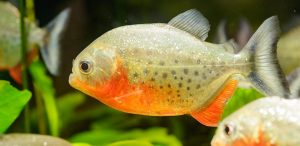
Advanced Level: Red-Bellied Piranhas
These fascinating fish have often been discussed in a negative light. Thoughts of packs of these fish tearing at flesh are what often comes to mind when someone brings up Red-Bellied Piranhas. It is true that they are extremely predaceous, so it’s best not to house them with other fish.
They certainly are not candidates for a community tank. The Red-Bellied Piranha is actually rather hardy and isn’t a picky eater. However, they grow to be quite large and will require a big tank to thrive in. They’re also extremely messy, making adequate filtration and meticulous upkeep important.
Something else to keep in mind when housing these fish is that they require a particular pH balance of between 6 and 7, which means they like soft, acidic water.
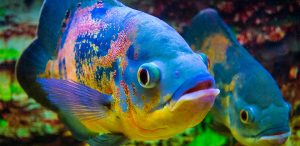
Advanced Level: Oscars
Oscars are another fish that belong to the Cichlid family. Though, unlike their angelic cousins, Oscars tend to grow to be quite hefty and swim around with a permanent scowl. If kept with other fish, they best be larger than the Oscar, as these fish are predatory animals. Any small or midsized community tank would be decimated by the introduction of one of these fish.
Keeping up with their care can be somewhat of a challenge, as they fish are messy eaters. Be sure the tank’s filtration is up for the challenge, as well as you, since frequent water changes will be in your future.
This small list has barely scratched the surface when discussing the fantastic world of freshwater fish. If you find that a particular species has caught your eyes, it’s best to do your research so that you fully understand the commitment that goes into that fish’s care. With enough practice and patience, your freshwater tank can look even more immaculate than those other fancy saltwater setups!
